The best cleaning tools to dust your home
Select independently determines what we cover and recommend. When you buy through our links, we may earn a commission. Learn more.
That dust accumulating in your home? It could be because you’re dusting wrong. One of the biggest mistakes people make while dusting is not using the right cleaning tool — bad dusters often push particles around and make more of a mess instead of removing them from surfaces altogether, says Marla Mock, president of home cleaning service Molly Maid.
SKIP AHEAD The best dusters to buy | What is dust? | How to dust properly | How to reduce dust in homes
To learn about the most effective dusters to shop for, we talked to cleaning experts, who also shared tips about how to dust different areas in our homes. Doctors also explain what dust is, as well as why some people sneeze and cough when they’re in dusty areas.
Our top picks
Best hand duster: Amazon Basics Microfiber Cleaning Cloths
Best reusable duster: OXO Good Grips Microfiber Extendable Duster
Best disposable duster: Swiffer Duster Extendable Handle Starter Kit
Best damp duster: Scrub Daddy Damp Duster
How we picked the best dusters
When shopping for dusters, experts told us to think about the following:
Type and size: Microfiber cloths, dusting wands, vacuum attachments and similar products all qualify as types of dusters. Choose one that’s appropriate for what you’re cleaning and make sure it’s the right size for the space.
Disposable versus reusable: Some dusters are designed for one-time use, while others are reusable and can be cleaned after they get dirty. Many options come with a reusable handle or base, and you add disposable duster refills each time you clean.
Material: Choose dusters that are soft and won’t scratch or otherwise damage surfaces. Some surfaces are particularly sensitive, like certain types of electronics or screens on tech. In these cases, experts recommend reading product care descriptions to learn about what materials to prioritize and avoid. Additionally, textured materials have a larger surface area compared to untextured materials, which means they can better pick up and trap dust as you’re cleaning, says Angie Hicks, chief consumer officer at Angi and co-founder of Angie’s List.
The best dusters of 2023
Below, we rounded up a handful of dusters that meet expert shopping guidance, some of which we’ve tried ourselves to learn how they work. We included dusters across type and size to highlight options that are suitable for different types of cleaning jobs.
Amazon Basics Microfiber Cleaning Cloths
Microfiber cloths are great all-around hand dusters to keep at home because they’re gentle on surfaces and act like a magnet for dust — the material attracts the tiny particles, lifts them off surfaces and traps them. And while you can use the cloths dry, damp cloths are much better at holding onto debris, Mock says. “A dry cloth may just push the dust around or create static that attracts more dust,” she explained. You can wet microfiber cloths with water, an all-purpose cleaning solution or disinfectant, but be careful not to add too much, as it can leave streaks on surfaces.
Amazon Basics has a set of 24, 36 or 48 machine-washable microfiber cleaning cloths, each of which measures 16-by-12 inches. The reusable cloths come in pink, gray and green or blue, white and yellow — you can designate different colors for different rooms or floors in your home. The microfiber material is soft and non-abrasive, and it won’t scratch delicate surfaces like glass, according to the brand.
Amazon Basics Microfiber Cleaning Cloths
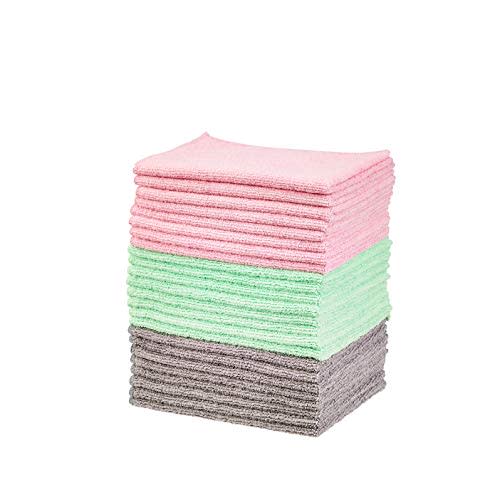
Amazon Basics Microfiber Cleaning Cloths $ at Amazon
Scrub Daddy Damp Duster
Scrub Daddy is a Select staff favorite brand, and cleaning with its Damp Duster sponge is comparable to using a wet microfiber cloth. Before each use, you dampen the foam sponge to soften it. Then, as you wipe the dust off surfaces, the sponge’s ridged exterior traps particles. The sponge also compresses so you can squeeze it into tight spaces. When the Damp Duster gets dirty, you can rinse it off and reuse it.
Scrub Daddy Damp Duster
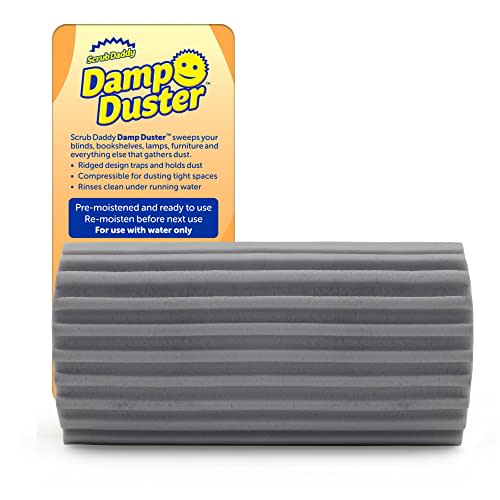
Scrub Daddy Damp Duster $ at Amazon
Scrub Daddy Damp Duster $ at Scrub Daddy
Scrub Daddy Damp Duster $ at Walmart
Swiffer Duster Extendable Handle Starter Kit
Swiffer’s fibrous, fluffy, disposable dusters have a three-dimensional shape. You slide them over the top of the brand’s reusable handle, which can extend up to three feet. You can also adjust the angle of the handle’s head depending on what you’re cleaning. I’ve used this duster for years and it helps me reach places like the tops of bookcases, shelves, ceiling fans and above door frames. I also slide it under furniture and appliances and use it to clean baseboards and moulding.
Swiffer’s dusters are recyclable as well. You can download a free shipping label from TerraCycle, pack all your used dusters in a box or envelope and send it to the recycling company. In addition to Swiffer’s unscented disposable dusters, I like the pet refills, which are fluffier and can trap large amounts of cat and dog hair.
Swiffer Duster Extendable Handle Starter Kit
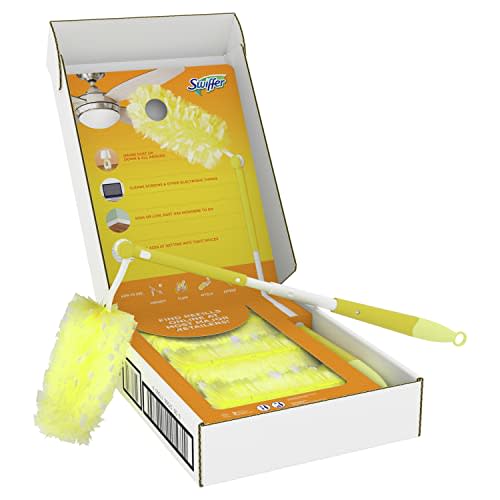
Swiffer Duster Extendable Handle Starter Kit $ at Amazon
Swiffer Duster Extendable Handle Starter Kit $ at Walmart
Swiffer Duster Extendable Handle Starter Kit $ at Target
OXO Good Grips Microfiber Extendable Duster
This OXO duster is similar to the Swiffer option above, but the entire thing is reusable, including the duster head. The duster’s handle extends from 24 inches to 53 inches in length— at its longest, the duster will likely help you reach ceiling fans, air vents and above door frames. The handle also has a soft, non-slip grip to keep your hand comfortable while cleaning. The reusable microfiber head rotates 270 degrees and locks in multiple positions so you can clean from different angles. When it’s time to clean the duster head, you unsnap it from the handle and throw it in the washing machine. You can purchase additional reusable duster heads to keep extras at home.
OXO Good Grips Microfiber Extendable Duster
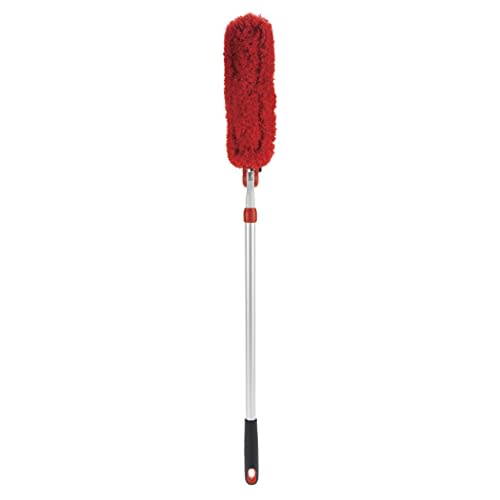
OXO Good Grips Microfiber Extendable Duster $ at Amazon
OXO Good Grips Microfiber Extendable Duster $ at Walmart
OXO Good Grips Microfiber Extendable Duster $ at Home Depot
Hiware Window Blind Duster Brush
Hiware’s Window Blind Duster Brush is one of our favorite cleaning gadgets. It's designed with three arms and comes with microfiber cloths to slip over them, allowing you to dust the tops and bottoms of multiple blades at a time. You can also use the tool to dust vents and air conditioners. When the microfiber cloth gets dirty, you can clean them in the washing machine.
Hiware Window Blind Duster Brush

Hiware Window Blind Duster Brush $ at Amazon
Hiware Window Blind Duster Brush $ at Walmart
Hiware Window Blind Duster Brush $ at Lowe's
Mr. Siga Flexible Microfiber Long Duster for Gap Cleaning
Some of the most common places people forget to dust are under appliances and furniture, Hicks says. It can be hard to fit dusters in these narrow spaces and reach all the way behind them, but Mr. Siga’s duster is specifically designed for these types of jobs. Its 19.7-inch wide microfiber duster head is flexible so you can bend it to fit into nooks and crannies. If you need to reach high or deep spaces, the duster’s handle extends from 46.9 inches to 65.7 inches. The microfiber cloth is reusable and machine-washable.
Mr. Siga Flexible Microfiber Long Duster for Gap Cleaning
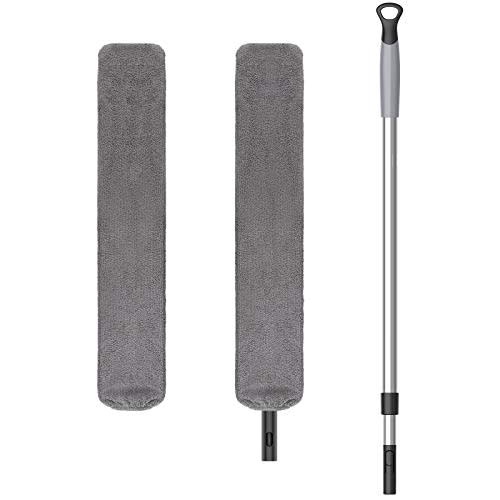
Mr. Siga Flexible Microfiber Long Duster for Gap Cleaning $ at Amazon
Royal Duster Black Ostrich Feather Duster
If used properly, feather dusters can be useful for cleaning delicate items like fine china, fragile knick-knacks or picture frames, Mock says. Move the duster in steady, even strokes and dust in one direction instead of moving the tool back and forth, which can stir up dust instead of picking it up.
This 12-inch-long feather duster is made from ostrich feathers and has a wooden handle. You can hand wash it by rinsing the feather off and letting them air dry, according to the brand.
Royal Duster Black Ostrich Feather Duster
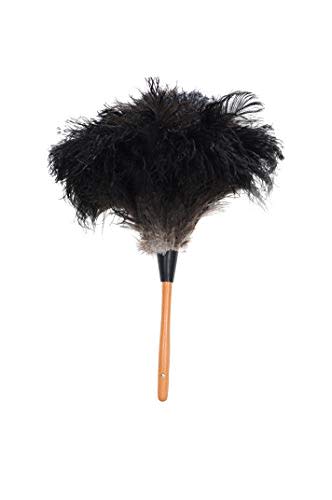
Royal Duster Black Ostrich Feather Duster $ at Amazon
Related: These clever tools are guaranteed to optimize space in your bedroom, kitchen, home office and more.
What is dust? What are dust mites?
Dust is a collection of particles including skin, fibers, hair, bacteria, soil, pollen and more, says Dr. Shradha Agarwal, an allergist and immunologist at Mount Sinai Health System’s Icahn School of Medicine. And if you’re in a particularly dusty area, you may experience symptoms like sneezing, coughing, itchy skin, watery eyes and even shortness of breath, she told us. However, feeling irritated by dust is different from having an allergy related to dust.
“When speaking in reference to allergies, we worry about dust mites,” Agarwal says. “Dust mites are arthropods that are found in the dust of homes located in regions where they are prevalent. They cannot be seen with the naked eye and feed off of organic matter such as skin scales, and bacteria and require moisture for survival.”
Dust mites are not usually found in dry climates, which is why they’re less prevalent in the western U.S. They thrive in warmer, wetter climates, and Agarwal says there are higher concentrations of dust mites in older homes prone to mold, homes with a lot of carpeting and homes that deal with other pests like roaches. Dust mite allergies can lead to inflammation inside the nose and asthma or eczema flare-ups, Agarwal explained. So while dusting is important regardless of where you live, it’s even more crucial if you live in an area where dust mites are found.
How to dust properly, according to experts
Yes, there is a right way to dust, although the majority of people dust incorrectly, experts told us. Dusting properly is crucial — it ensures you’re actually lifting dust off surfaces and removing it from your home. Otherwise, you might just be moving dust around or putting it into the air.
Below, experts share tips for effective dusting. While you’re cleaning, Agarwal recommends wearing a face mask so you don’t inhale any of the dust particles that might make their way into the air.
Dust from top to bottom, or in one horizontal direction
While you’re cleaning higher areas, some particles fall onto surfaces beneath them. That’s why it’s important to dust from top to bottom — once you get to the lower areas, you can collect the dust that was there in the first place, plus any that made its way down during the cleaning process. Mock also recommends dusting first, then vacuuming. The vacuum can suck up any dirt and debris that got onto the floor while you were dusting.
If you’re dusting horizontally, make sure to clean in one direction (either right to left or left to right) instead of going back and forth. Doing so ensures you don’t already clean areas dirty again, Mock says.
Don’t forget about these commonly missed spots
People most often forget to dust hard-to-reach areas in their homes, Mock says. This includes ceiling fans, light fixtures, behind furniture, the tops of door frames and under appliances. Ignoring these spaces allows layers of dust to build up over time, eventually creating dust bunnies, which are small clumps of dust, lint, hair and other debris.
Clean or swap out your dusters
Be sure to clean reusable dusters after every job, or trash used disposable dusters and swap them out for new ones. Even if your duster doesn't look dirty, it likely has microscopic dust particles on it that you can spread to other surfaces. Start every new clean with a fresh duster to avoid that.
How often should you dust?
Experts agree that you should dust surfaces in your home at least once a week. However, dusting frequency depends on factors like the size of your home, the level of foot traffic and activity and the types of surfaces you’ll be cleaning, Mock says. If you have pets, consider increasing the number of times you dust a week, especially during shedding seasons, Hicks says. Pet hair and dander contribute to dust buildup in homes, and more shedding means more dust.
Additionally, if you live in an area where dust mites are prevalent, you should dust more frequently. Mock recommends dusting after home improvement projects or renovations as well, as they tend to create a lot of dust.
Related: Corded, cordless and handheld vacuums to help you get rid of pet hair on every surface in your home.
The best ways to reduce dust and dust mites in your home
If your home is particularly dusty, spend some time identifying the root cause, Hicks says. Doing so can reduce how much and how fast dust builds up, making regular weekly maintenance easier. Here are some steps you can take to reduce dust and dust mites in your home.
Regularly clean fabric and upholstered surfaces: Dust mites usually settle on bedding, upholstered furniture, curtains, drapes and carpeting, not hard surfaces like wood, Agarwal says. Cleaning these surfaces weekly helps remove and kill dust mites, and you can also put dust mite-impermeable encasings on mattresses, box springs and pillows, she noted. Additionally, try not to add a lot of additional fabric into your home from decor like accent pillows or stuffed animals, for example.
Use an air purifier and/or dehumidifiers: Air purifiers with HEPA filters can help remove dust particles and other allergens like pollen, dander and pet hair from the air, while dehumidifiers can reduce condensation in homes. “Dust mites have decreased survival and multiplication when humidity is below 50% consistently,” Agarwal says. Also be sure to repair any leaks in your home, as that could also contribute to the buildup of moisture.
Keep your air conditioner and furnace filters clean: Furnace and air conditioner filters “do an amazing job of preventing outdoor dirt and dust from entering your home,” Hicks says. But if they’re dirty, they’re not as effective as they’re designed to be. Be sure to clean or replace these filters on a regular schedule to ensure they’re doing their jobs. Similarly, cleaning your air ducts to maintain healthy indoor air quality is also important, Hicks says. You should swap out the filter on your air purifier periodically, too.
Close your windows: Open windows provide fresh air and a nice breeze, but they allow debris from the outdoors to flood inside your home, Hicks says. Dirt and pollen that comes inside eventually settle on surfaces, which creates more dust and circulates in the air, so you breathe it in.
Meet our experts
At Select, we work with experts who have specialized knowledge and authority based on relevant training and/or experience. We also take steps to ensure that all expert advice and recommendations are made independently and with no undisclosed financial conflicts of interest.
Marla Mock is the president of home cleaning service Molly Maid, a Neighborly company.
Angie Hicks is the chief consumer officer at Angi and the co-founder of Angie’s List.
Shradha Agarwal is an allergist and immunologist at Mount Sinai Health System’s Icahn School of Medicine.
Why trust Select?
Zoe Malin is an associate updates editor at Select. She’s written various home care stories about dish soap, eco-friendly cleaning products, disinfectants, vacuums for pet hair and more. For this piece, Malin talked to two cleaning experts to learn about how to dust and the best products to do so, and use their guidance to research products. She also spoke with a medical expert to learn about how dust impacts our health.
Catch up on Select’s in-depth coverage of personal finance, tech and tools, wellness and more, and follow us on Facebook, Instagram and Twitter to stay up to date.
